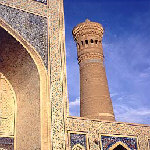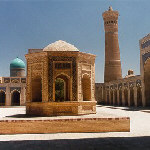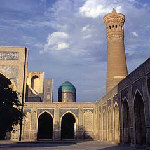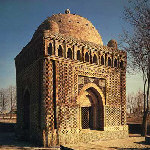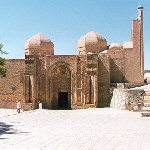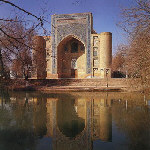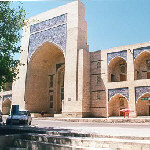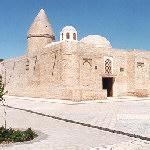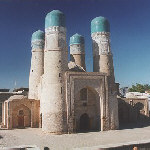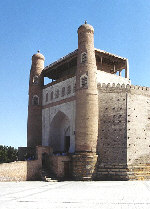|
Bukhara is one of the most ancient cities of Uzbekistan, situated on a sacred hill, the place where sacrifices were made by fire-worshippers in springtime. This city was mentioned in a holy book "Avesto". The city is supposed to be founded in the 13th c.B.C. during reign of Siyavushids who came to power 980 years before Alexander the Great. The name of Bukhara originates from the word "vihara" which means "monastery" in Sanskrit. The city was once a large commercial center on the Great Silk Road. Bukhara lies west of Samarkand and was once a center
of learning renowned throughout the Islamic world. It was here that
the great Sheikh Bahautdin Nakshbandi lived. He was a central figure
in the development of the mystical Sufi approach to philosophy,
religion and Islam. In Bukhara there are more than 350 mosques and
100 religious colleges. Its fortunes waxed and waned through succeeding
empires until it became one of the great Central Asian Khanates
in the 17th century. Kalyan Minaret was erected in 1127 by Arslan-Khan and is considered to be the symbol of the city. According to the records of the time, the builders made an error in its construction, and it soon fell to the ground. When the remnants were cleared away, Arslan-khan ordered that a new minaret, stronger and more beautiful, the likes of which had not been seen in the entire East or in Bukhara, be built. The Kalian Minaret rises to a height of forty-six
meters above the city. The minaret is decorated with 14 parallel
bands, which are not repeated. During the repairs in 1924, the minaret
was faced with glazed bricks where the frieze had been. The most ancient architectural masterpieces in Bukhara
were constructed in the 9th -10th centuries. The Mausoleum of Samani,
one of the most famous monuments was well-preserved. The Muslims
Mausoleum is one of the best illustrations to the history of the
state of Samanids (875-999). It was the period of cultural upsurge
of the state. The Mausoleum was built as a family crypt immediately
after the death of Ismail Samanid's father. Later, Ismail Samani
himself and his grandson Nasr were also buried in it. Even after
his death a lot of people looking for justice came to the holy grave
still considering him to be the ruler of the state. None of the ancient monuments of the city have caused as many puzzles for archeologists and historians as this one. The name of the mosque itself indicates the approximate time of its construction: the first part of the name, "Magoki", means "a pit" or "a hole" and suggests that the mosque stood much lower than the present level of the city streets and squares. Ancient Bukharians prayed to the fire; they belonged
to the Zoroastrian religion. Each family had its own idol, and thought
if they prayed to the idols, they would receive happiness and richness.
These idols were sold twice a week at the bazaars. Mokh was the
king of that time and he himself controlled the marketing. In order
to develop trade in the city, he ordered the construction of a temple
for the fire-worshippers. The most popular place among Bukharian people is the architectural structure of the square that took shape during 16-17th centuries. Around 1620 the Khan's grand vizier, Nadir Divanbegi, built a beautiful pool of Lyabi-Khauz. Here people could listen to medda (public reciters), take part in the religious discussions, which were described in "Stories of an Indian traveler" by Abd ar-Rauf. Not content with his pool the grand vizier flanked it with two grand buildings in his own memory: the Nadir Divanbegi Madrassa and khanako, both completed around 1620. The north side of the complex is formed by the Chashma Ayub Madrassa. From the Ulugbek and Abdulazizkhan Madrassa along
the street flowing into the labyrinth of narrow, winding streets
of old Bukhara, you can find a monument that is not so old, but
which is notable for its architecture - the Chor-Minor Madrassa,
which was built in 1807 by Khalif Niiazkul. He built the Madrassa
with a cozy courtyard and a pond, a summer mosque, and a four-turret
building. Char-Minor means "the four minarets". It draws
attention to itself with its unusual architectural form, the main
focus of which is the four turrets with their sky blue cupolas,
which have nothing in common with ordinary minarets. The time of construction of this monument is thought to be the beginning of the 1st millennium A.D., but it is entirely possible that some sort of fort or temple stood on this site even earlier. From the most ancient times the Ark was the fortified residence of the rulers of Bukhara. Everything could be found there - palaces, temples, barracks, offices, the mint, warehouses, workshops, stables, an arsenal, and even a prison. The overall area of the fortress with all palaces,
buildings, and fortifications is 34,675 square meters. Before there
were two gates, at present time, only the western gate restored
in 1921-1923, remains. |
|

